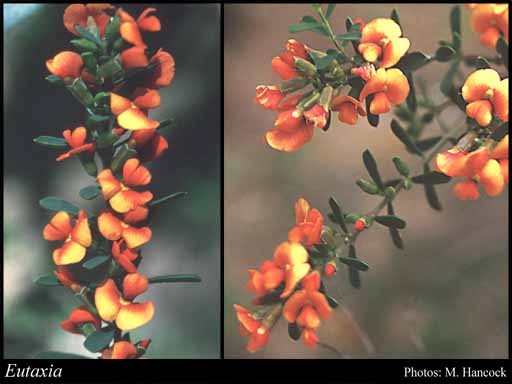- Reference
- Hort.Kew. [W. Aiton] 3:16 (1811)
- Name Status
- Current

Scientific Description
Family Papilionaceae. Mirbelieae.
Sometimes included in Leguminosae.
Habit and leaf form. Shrubs (mostly glabrous). Plants unarmed. Leaves cauline. Plants with neither basal nor terminal concentrations of leaves. Mesophytic, or xerophytic. Leaves minute to small; opposite; decussate; simple; epulvinate. Leaf blades dorsiventral; entire; flat, or rolled, or solid; grooved adaxially, or not grooved. Leaves with stipules (the stipules minute), or without stipules. Stipules free of one another. Leaf blade margins entire; flat, or involute.
Reproductive type, pollination. Fertile flowers hermaphrodite. Unisexual flowers absent. Plants hermaphrodite. Entomophilous.
Inflorescence and flower features. Flowers solitary, or aggregated in ‘inflorescences’; when solitary, axillary; 1–4 per axil; when aggregated, in fascicles. Inflorescences axillary; often with fascicles of 2–4 flowers, crowded in the upper axils, or with solitary axillary flowers. Flowers pedicellate; (bi-) bracteolate (the bracteoles distant from the calyx, often very small); very irregular; zygomorphic. The floral asymmetry involving the perianth, or involving the perianth and involving the androecium. Flowers papilionaceous; tetracyclic. Floral receptacle developing a gynophore, or with neither androphore nor gynophore. Free hypanthium present, or absent. Hypogynous disk present; intrastaminal; annular. Perianth with distinct calyx and corolla; 10; 2 -whorled; isomerous. Calyx present; 5; 1 -whorled; gamosepalous; five lobed. Calyx lobes about the same length as the tube. Calyx exceeded by the corolla; bilabiate (the posterior pair of lobes broader and more or less connate); non-fleshy; persistent; non-accrescent; with the median member anterior. Corolla present; 5; 1 -whorled; appendiculate, or not appendiculate. Standard not appendaged. Corolla polypetalous, or partially gamopetalous. 2 of the petals joined. The joined petals anterior (the keel members). The wings of the corolla free from the keel; not laterally spurred. Standard ‘normally’ developed; entire (‘circular’). Keel conspicuously exceeded by the wings (and rather straight); not long-acuminate/beaked; neither coiled nor spiralled; not bent and beaked. Corolla imbricate; yellow, orange, red, and brown (in combibations); deciduous; non-accrescent. Petals rather long clawed. Androecial members definite in number. Androecium 10. Androecial sequence determinable, or not determinable. Androecial members free of the perianth; all equal to markedly unequal; free of one another; 1 -whorled. Androecium exclusively of fertile stamens. Stamens 10; all more or less similar in shape; diplostemonous; both opposite and alternating with the corolla members; filantherous. Anthers separate from one another to connivent; all alike; dehiscing via longitudinal slits; latrorse, or introrse. Gynoecium 1 carpelled. The pistil 1 celled. Carpels reduced in number relative to the perianth. Gynoecium monomerous; of one carpel; superior. Carpel stylate. Style (in-) curved (filiform), or hooked (then short and thick). Style terete. Stigmatic tissue terminal. Carpel 2 ovuled. Gynoecium median. Ovary subsessile, or stipitate. Stigmas punctiform (small). Ovules slenderly or shortly funicled.
Fruit and seed features. Fruit subsessile to sessile; non-fleshy. The fruiting carpel dehiscent; a legume. Pods somewhat elongated (ovate to oblong in outline); not triangular; straight; becoming inflated, or not becoming inflated; more or less flat, or somewhat compressed, or terete; not constricted between the seeds; not transversely septate; wingless. Fruit 1 celled. Dispersal unit the seed. Fruit 1–2 seeded. Seeds reniform to oblong in outline; not mucous; arillate. Embryo bent (radicle inflexed). Testa non-operculate.
Geography, cytology, number of species. Native of Australia. 2n = 16 (32). A genus of 11 species; 10 species in Western Australia.